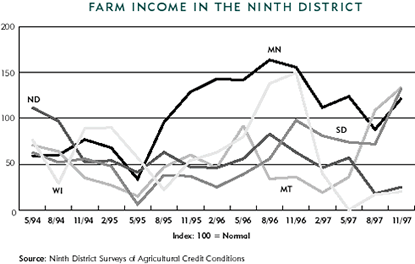"You shouldn't farm if you don't like living with a lot of risk." That blunt warning was given some years ago by University of Minnesota farm extension educator Earl Fuller, and is supported by the adjacent graph. An index of bankers' estimates of farm income for five Ninth District states over the past five years, the graph demonstrates the ups and downs of farm income resulting from fickle weather and prices.
North Dakota and Wisconsin, for example, had the highest rating among the five states as 1994 began, and the lowest at the end of 1997. North Dakota farm income, buffeted by adverse weather, recurrent plant diseases such as scab and vomitoxin, and low wheat prices, declined quite steadily over the period, with only a brief spike in late 1996. Wisconsin farmers rode a roller coaster, leading other states in 1994 and early 1995, dipping down until the brief euphoria of $20 milk in 1996 and then falling into the cellar as milk prices declined again in 1997.
South Dakota farmers seemed stuck in a rut from 1994 into early 1996, largely as a result of bad weather and low cattle prices, but their fortunes rose with better weather and more favorable prices in 1996 and 1997. Montana held the low spot for several quarters due to low cattle prices, but ended the period at the top of the heap as improved beef prices in 1997 and a good crop reinvigorated farm and ranch finances.





